Quality communication is the lifeblood of collaboration and productivity.
It allows us to understand our professional surroundings and our individual responsibilities and provides all the necessary information to perform our tasks effectively.
Unfortunately, we all experience communication challenges that can occasionally muddy the waters of professional communication.
The real problems occur when we don’t take steps to address those issues on time.
But, if you feel like you’ve passed the point of no return, you’ve come to the right place! We’ve laid out the solutions to your communication challenges in the list below.

Table of Contents
Challenge #1: Lack of communication
Many organizations struggle with providing a sufficient amount of information to stakeholders, whether it’s work-related info, knowledge resources, news updates, or simply room for active discussion.
However, this lack of communication can lead to important information being lost, which may cause delays in important work projects.
On top of that, infrequent communication can create a vacuum in which rumors and hearsay thrive, due to unaddressed misunderstandings and breakdowns in individual and collaborative work.
Perhaps worst of all, a lack of communication can create a sense of isolation in employees, decreasing their engagement and emotional investment in their work.
How to overcome a lack of communication in the workplace
Fortunately, there are ways to overcome a lack of communication in your organization, such as:
- Providing a comprehensive communication platform that enables both active discussion and an effective distribution of information, and
- Keeping everyone in the loop through company-wide emails and messages, newsletters, intranet updates, all-hands meetings, etc.
Make communication a habit by opening up those communication channels, as shown in this example of company-wide communication on Pumble, a business messaging software.
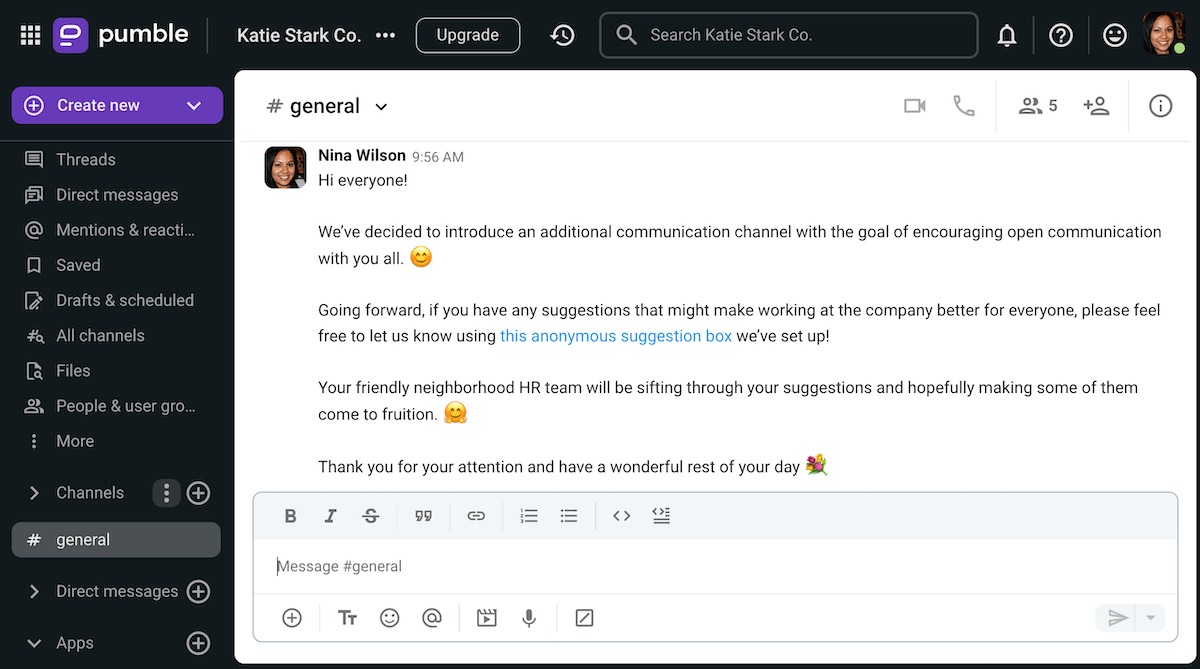
Give your communication a boost with Pumble
Challenge #2: Information overload due to oversharing
As damaging as complete lack of communication is for employee morale, oversharing can be just as troublesome.
Overwhelming your employees with excessive information is a surefire way to achieve information overload.
In practice, corporate oversharing usually looks like:
- Overstuffed email inboxes,
- An unrelenting barrage of company-wide memos,
- Calendars full of unnecessary meetings (eventually leading to meeting burnout), as well as
- Digital clutter in the form of countless shared files and questionably useful links.
These constant distractions make it impossible for your employees to engage in focused work. Having to sift through the swarm of data coming their way tends to have a detrimental effect on employee motivation, engagement, and productivity.
How to overcome information overload in the workplace
So, how can we avoid the negative outcomes of information oversharing?
Well, the key lies in finding the right balance between enough and too much information — which can differ from team to team.
In general, you should:
- Prioritize the quality of information over quantity,
- Limit your content distribution channels,
- Filter information for increased clarity, and
- Continually assess the ratio of time spent on processing information and the value it provides.
Organize your communication on Pumble
💡 PUMBLE PRO TIP
Information overload and overcommunication are often considered synonymous, but the practices are quite different. Read the following article to learn more:
Challenge #3: Lack of formal communication structure
Navigating workplace communication without a formal communication structure is one of the biggest communication challenges for newer companies.
A clear structure of communication and information channels ensures that everyone has easy access to all relevant information, which is a necessary part of workplace communication.
Your employees should know exactly where they can find important information such as company updates, policies, work tools, and knowledge resources.
Ultimately, unstructured communication can lead to confusion, performance loss, and communication breakdowns because:
- Important information gets lost, delayed, or overlooked,
- Time is wasted seeking information,
- Relevant connections aren’t established, and so on.
So, how can organizations systematically prioritize clear and efficient communication?
How to overcome a lack of formal communication structure at work
The means and resources you use to overcome this communication challenge will depend on the preferences of your organization, and it is important to note that you don’t have to utilize all of them.
However, some of the solutions you can implement include:
- Establishing an open-door policy within the company,
- Organizing cross-department workgroups for matters that require the participation of multiple teams,
- Utilizing Intranets, newsletters, and bulletin boards, if you deem those channels to be useful in your specific circumstances, and
- Organizing the channels on your team communication app to simplify communication, as shown in the image below.
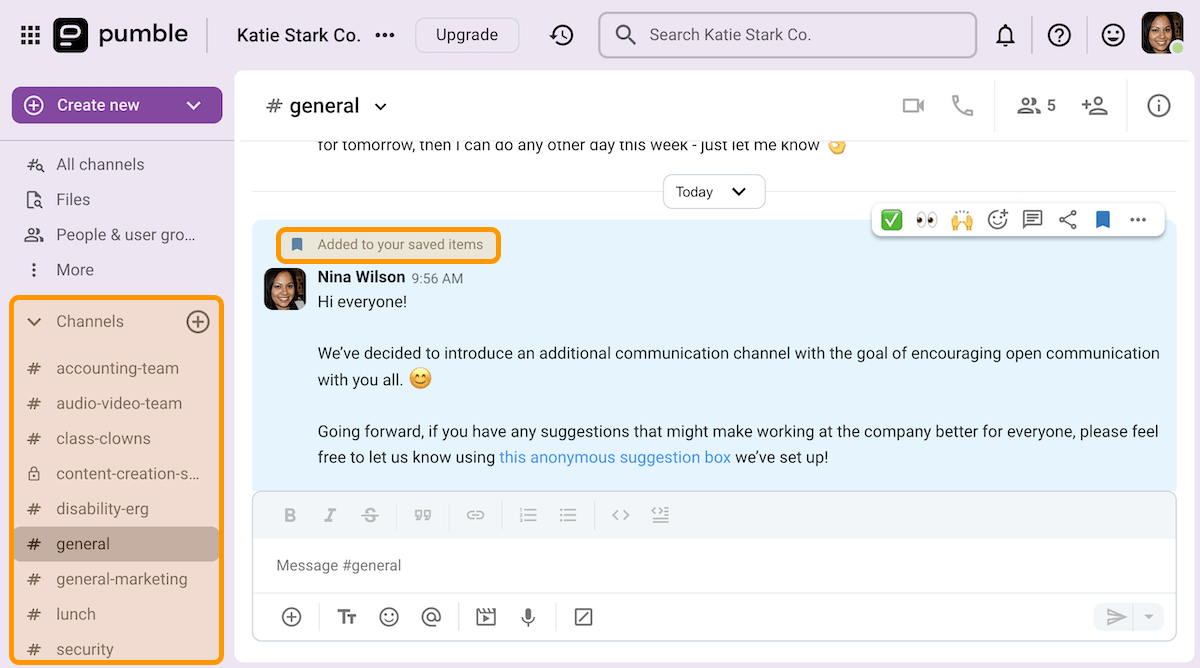
Challenge #4: Lack of knowledge sharing due to information silos
Not having access to all the information they need to do their jobs can make employees waste time performing tasks that will undoubtedly require revisions.
But, that isn’t the only potential drawback of information gatekeeping.
When valuable know-how isn’t shared effectively on an organization level, companies run the risk of losing that expertise and understanding when individuals leave.
Moreover, when knowledge gatekeeping occurs as the result of information silos — which limit information sharing to smaller groups or teams within the organization — it can create a lack of trust in the company. That can cause a higher employee turnover rate.
As a result, companies have to put time and resources toward recruiting and training new hires.
Conversely, active knowledge sharing increases the sense of recognition of individual team members, thus improving employee engagement and retention.
How to overcome a lack of knowledge sharing in the workplace
So, how can you make the knowledge of individuals and teams within the company accessible to the rest of the collective?
To improve knowledge sharing and discourage the formation of information silos, organizations should strive to:
- Build and maintain a dedicated knowledge base,
- Incentivize knowledge sharing by openly recognizing and rewarding individual efforts, and
- Encourage collaboration between disparate individuals and teams.
Break down information silos with Pumble
Challenge #5: Lack of cross-team coordination
Communication and coordination are essential elements of team collaboration.
When different parties involved in a collaboration fail to fully communicate all relevant aspects of their shared work, it is an indicator of poor coordination.
Generally, this communication challenge stems from a lack of understanding of how collaboration is supposed to work and how the individual pieces should fit together.
As such, poor coordination can have damaging effects on the collaborative process, resulting in:
- Ineffective work, as people are confused about what they’re supposed to be doing,
- Repeat activities, as employees are forced to perform the same tasks multiple times due to a lack of clarity, as well as
- A rise in employee dissatisfaction levels and interpersonal conflicts.
How to overcome a lack of cross-team coordination at work
To overcome this communication challenge, organizations should:
- Clearly communicate the purpose and the mechanics of the collaboration from its very inception,
- Define team goals, as well as individual roles and responsibilities,
- Establish and maintain clear lines of communication between the collaborators, and
- Take steps to identify the causes of coordination breakdowns if/when they occur and adjust accordingly throughout the collaborative process.
We can see an example of that final point in the interaction below.
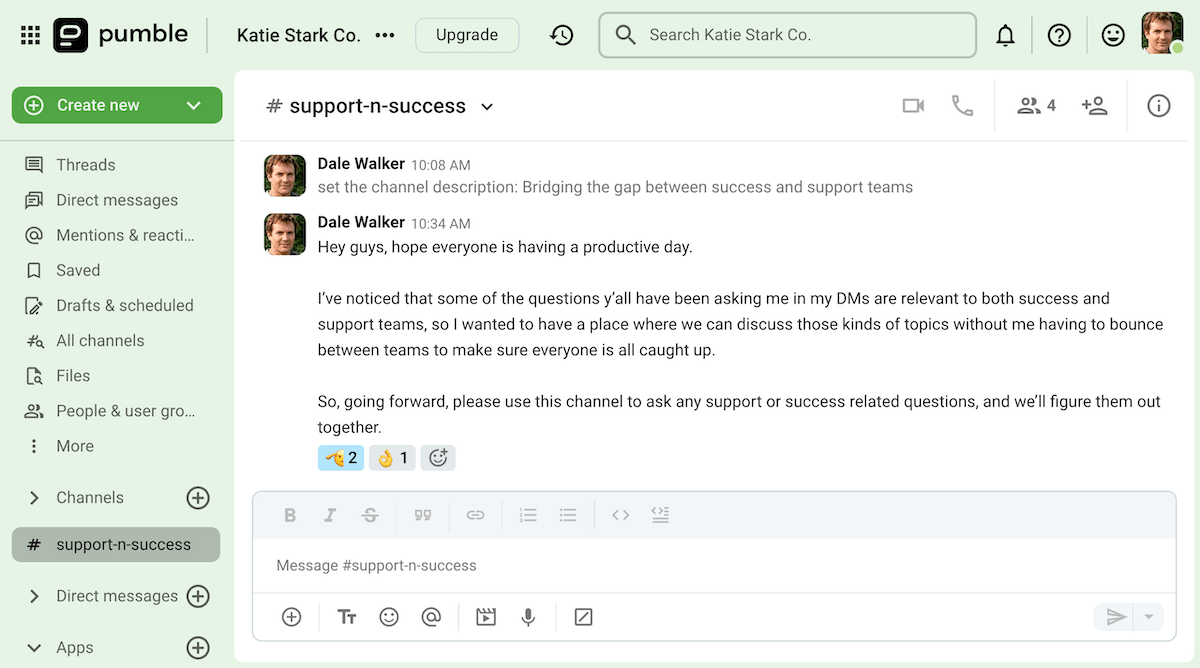
Challenge #6: Lack of feedback
Giving and receiving feedback is one of the most important aspects of work communication.
While constructive feedback can keep team members appraised of how their work is being perceived, it can also help:
- Identify any emerging issues,
- Increase employee engagement due to heightened visibility and recognition, and
- Shape and improve organizational processes.
Conversely, irregular and inadequate feedback can cause both immediate and long-term issues.
Without feedback, team members lack clarity and direction regarding their work, which can negatively impact their performance.
Not providing feedback can also make employees demotivated and disengaged from their work and the organization.
On top of that, not receiving employee feedback prevents organizations from recognizing existing internal challenges and improving their processes.
How to overcome a lack of feedback in the workplace
Luckily, all this can be avoided by making a concerted and systematic effort to seek and provide feedback by:
- Establishing channels that enable and encourage upward communication (making it easier for employees to ask their managers for feedback), and
- Asking team leaders and managers to regularly provide and seek feedback through 1-on-1 meetings, team meetings, and employee surveys.
In other words, companies should not only provide feedback, but also make a point of listening to employee feedback and, crucially, acting upon it when necessary.
Give and ask for feedback on Pumble
💡 PUMBLE PRO TIP
Experts in the people management field have recently taken to thinking of feedback as a process that should primarily focus on influencing future actions, rather than merely reflecting on past performance. To learn more about this mindset, check out the following article:
Challenge #7: Motivation concerns
A lack of motivation is a unique communication challenge you may see at work.
Not being able to motivate your employees can lead to all kinds of negative outcomes, including:
- Missed deadlines,
- A decrease in employee engagement, and
- A general sense of detachment in your workforce.
Conversely, knowing how to address these motivation concerns should inspire your employees to get their work done even when the going gets tough.
Of course, the difficulty comes in finding a method that works for most of your team.
If you manage to motivate some of your employees while the others remain listless, it may lead to social loafing — a situation in which some people don’t put as much effort into their work as others, which can further reduce team motivation.
How to overcome a lack of motivation in your team
So, what’s a manager to do?
Well, beyond sharing some teamwork and team communication quotes to get your team to snap out of their stupor, you could try your hand at transformational leadership.
In other words, you should become someone others can be inspired and motivated by.
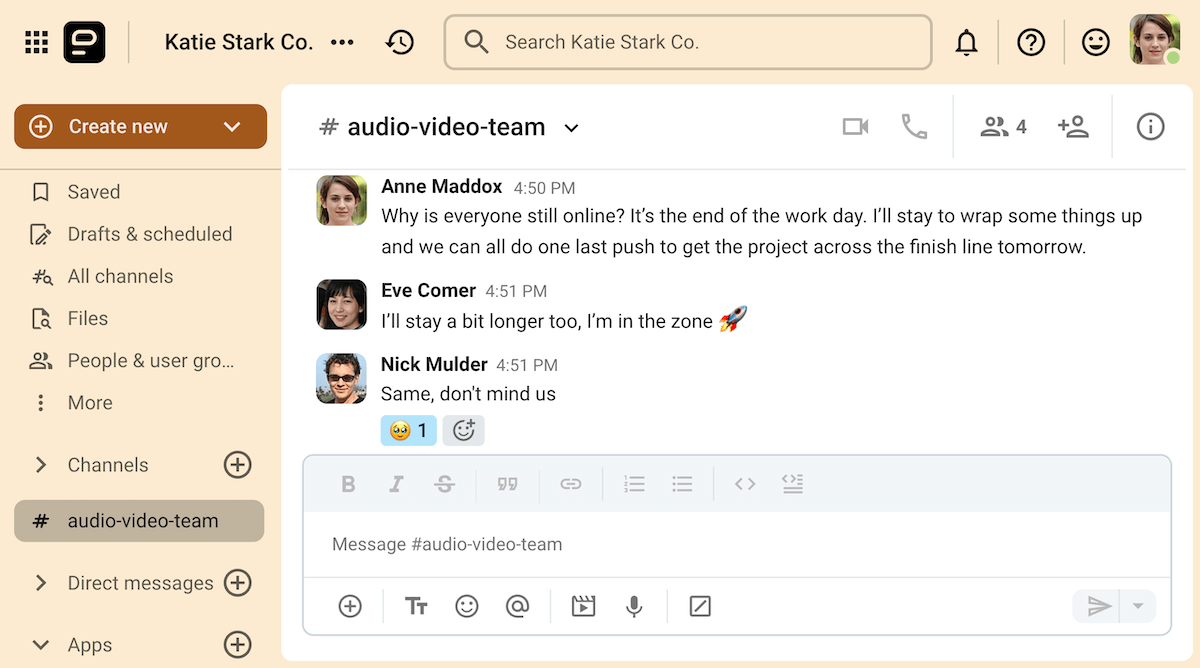
Challenge #8: Lack of engagement
Low employee engagement can negatively impact a company’s overall productivity, morale, and turnover rates.
Conversely, high employee engagement tends to lead to better work outcomes such as:
- Reduced employee absenteeism (as employees are more likely to show up if they feel connected at work),
- Lower employee turnover (because fewer employees seek other jobs if they are focused on their current job),
- Decreased burnout rates (because people tend to be happier when they care about the work they’re doing), and even
- Increased profits (due to the positive effect on performance — and not having to train new hires).
Yet, despite these benefits, only 21% of all employees can claim to be truly engaged at work.
So, what can you do to improve that percentage within your organization?
How to overcome a lack of engagement among your employees
If you’re looking to boost employee engagement, start thinking of your organization as a content hub.
Within that context, encouraging employees to engage with the content your company produces — such as your internal announcements, vision statements, and even external messaging — may be one way to raise engagement.
This can be accomplished by:
- Responding to company announcements on the internal messenger with emoji reactions,
- Creating an official social media accounts for celebrating employees, and
- Inviting employees to engage with external messaging by sharing it on internal communication channels as well.
Another way to raise engagement would be to openly and frequently celebrate your successes, big and small, as a team.
💡 PUMBLE PRO TIP
If you’re looking to devote more time to your internal communication strategy, the following article should simplify the planning process:
Challenge #9: Concealing or softening negative information
The practice of concealing or softening negative information is one that can adversely affect workplace communication in several ways.
On the one hand, when employees keep bad news from their superiors, they tend to do so out of fear of repercussions.
However, hiding negative information in those cases can make even minor mistakes snowball into much larger issues.
Conversely, in downward communication, filtering negative information in the interest of keeping the peace or showing the company in a more positive light can erode trust in the company.
How to overcome concealing or softening negative information at work
If your organization subsists on this kind of message filtering, you can still encourage transparent communication by:
- Creating a sense of psychological safety by not penalizing employees who come to you with bad news,
- Having difficult conversations with your employees if the bad news you have concerns them and their livelihoods, and
- Building trust in the company, which will keep employees from assuming the worst the next time you have to keep information confidential.
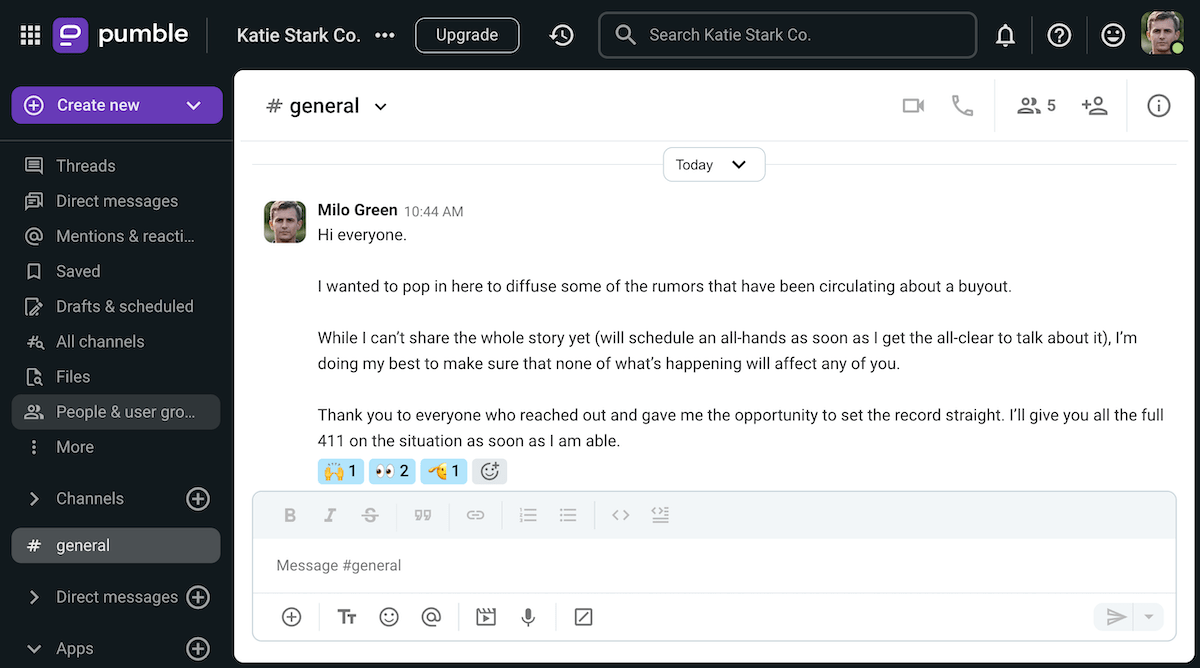
Build trust and connect with your coworkers over Pumble
Challenge #10: Negative attitudes
Workplace communication is often impeded by communication barriers, defined as behaviors or perceptions that prevent people from communicating effectively.
Negative attitudes are primarily influenced by common variables such as:
- Age,
- Gender,
- Education,
- Experience,
- Upbringing,
- Lifestyle, or
- Race.
They are commonly expressed through behaviors such as prejudice, stereotyping, or emotionality.
These behaviors are divisive by nature, meaning that they tend to sow misunderstanding, disagreement, and conflict.
How to overcome negative attitudes in the workplace
Since negative attitudes can be incredibly difficult to eliminate once they take root, organizations should focus on implementing good DEI practices and:
- Being respectful and inclusive to all team members,
- Using affirmative tone and language that focuses on positives, and
- Encouraging feedback.
If negative attitudes still manage to contaminate workplace communication despite these precautions, HR should waste no time and intervene by issuing disciplinary action forms.
💡 PUMBLE PRO TIP
If someone on your team is exhibiting negative attitudes, there are plenty of steps you can take to deal with their behavior. To learn more, check out this guide:
Challenge #11: Self-censoring due to social status
Status consciousness is a communication barrier that can cause people to behave differently when communicating with those in lower or higher positions within the company due to a heightened awareness of the organization’s hierarchy.
This invisible wall between subordinates and higher-ups can discourage team members from:
- Expressing their concerns,
- Discussing the issues they experience, and
- Communicating negative information to their superiors.
It can even influence the way employees express their thoughts when speaking to higher-ups, in an act of code-switching.
On the other hand, status consciousness can also prevent team leaders and upper management from considering the input of their subordinates out of self-importance.
How to overcome self-censoring due to social status at work
So, how do you overcome this particular communication challenge?
Well, making your organization more democratic by encouraging open and honest communication on all levels should help.
However, the first step to achieving this result must be taken on the micro level — by training managers to actively seek out and recognize the input of their immediate team members.
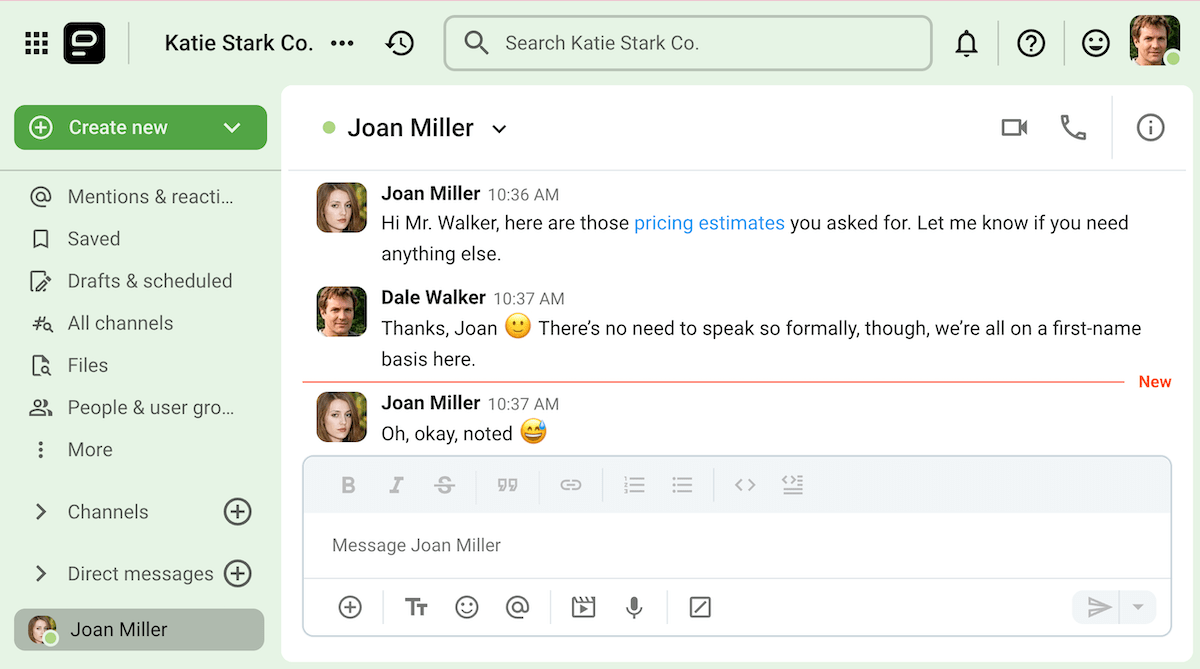
Challenge #12: Cultural differences
The cultural differences that may exist between coworkers in multicultural teams can affect workplace communication in many different ways.
For one, people who come from different cultural backgrounds may have different approaches to communication, both verbal and nonverbal, as well as different cultural norms they may adhere to.
For example, a Korean worker may be more inclined to subscribe to a strictly hierarchical organizational structure than your average Silicon Valley employee because Korean culture places a heavy emphasis on seniority.
Conversely, the tech industry favors a flatter organizational structure, so the Silicon Valley employee might be surprised by the Korean employee’s insistence on respectful behaviors between superiors and subordinates.
Then again, these relatively harmless behaviors aren’t the only way cultural differences might manifest in the workplace.
In the worst-case scenario, they may lead to ethnocentrism and stereotyping, which can derail any attempt at cross-cultural collaboration.
How to deal with cultural differences in the workplace
To prevent the conflicts that may arise due to cultural differences, corporations should make an effort to expand their understanding of other cultures by providing cultural intelligence education to their employees.
After all, these differences between us should make us more curious about each other and more prepared to listen and learn from each other.
So, by increasing our understanding of the cultural context our colleagues (and we) exist in, we can create a more compassionate workplace.
💡 PUMBLE PRO TIP
Did you know that cultural differences can influence our emoji use? To learn more, check out this article:
Challenge #13: Time zones
Time zones are arguably a far more tangible communication challenge for international businesses than cultural differences — though the 2 can certainly coexist in teams distributed across distant geographical locations.
When teams’ overlapping work hours are limited or non-existent, the resulting overlooked messages and inconsistent communication can cause unnecessary delays and dips in productivity.
Furthermore, having those slim windows of opportunity when different team members are online can:
- Significantly narrow meeting windows,
- Cause a lack of social interaction between employees, and
- Create a lack of opportunities for individual recognition.
How to deal with working across different time zones
Fortunately, there are ways to adjust to working across time zones, and they mostly rely on implementing elements of asynchronous communication such as:
- Prioritizing clear and effective written communication,
- Establishing clearly defined team roles, work processes, and guidelines,
- Respecting both professional boundaries and cultural differences, and
- Using asynchronous collaboration and communication tools that allow employees to communicate across time zones.
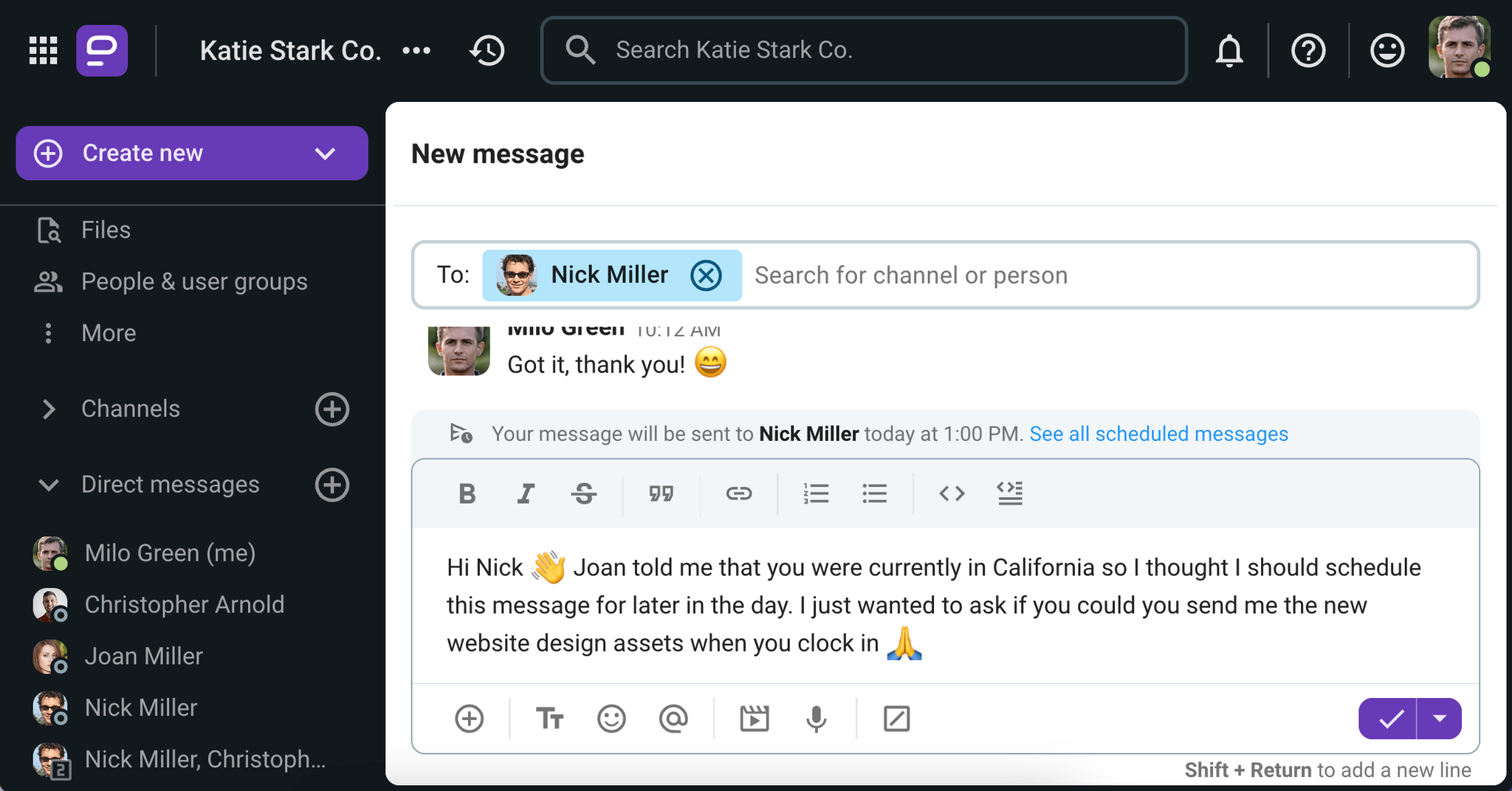
Communicate across time zones with Pumble
Challenge #14: Poor written communication
In a modern work environment, a large volume of communication takes place in writing — whether or not your team is working across time zones.
Because of that, we must pay special attention to the kind of language we use to communicate, especially when dealing with company-wide communication and distribution of information.
Not paying attention to grammar, clarity, and structure in official documents can damage the perception of the organization in the eyes of employees, suggesting a lack of professionalism and attention to detail.
Furthermore, poor written communication can also have practical consequences, as poorly worded messages (such as unclear directions, jargon-filled text, using complex wording, etc.) can create confusion and uncertainty, which can have a negative effect on both employee performance and satisfaction.
How to overcome poor written communication at work
Many organizations hire communications specialists to handle the creation and distribution of company-wide content in the interest of overcoming this communication challenge.
However, if you’re looking for ways to improve your written communication skills on an individual level, you can just work on improving your work message skills.
Luckily, that should be pretty easy if you focus on being clear, concise, and polite above all.
💡 PUMBLE PRO TIP
Using too much industry jargon is a surefire way to spark your coworkers’ annoyance. Still, that doesn’t mean that you should steer clear of certain professional phrases altogether. Find out which common business communication buzzwords are fair game by reading the following article:
Challenge #15: Technology
Whether you work on-site or in a position that has some degree of hybrid work baked into it, chances are that most of your workplace communication is facilitated by technology.
With that in mind, we should point out that most of the communication tech you rely on can turn on you at the drop of a hat:
- Phones can go out of service,
- Internet signals can disappear, and
- Email can get hacked.
And, though most of those issues are out of your control, one thing you can do is choose the best team communication tool for your team.
How to overcome technology issues in the workplace
The most important consideration you should have while choosing a business messaging app is the level of security it can offer.
Picking a tool like Pumble, which has high security standards and internationally recognized certifications for data safety, is a good place to start.
It’s also a good idea to opt for an app that has satisfactory uptime levels — that way you’ll know the app won’t die on you when you least expect it. Pumble offers its users 99.99% uptime levels, which means that you’ll be able to keep chatting as long as you have access to the Internet.
Pumble turns communication challenges into opportunities for better communication
Though many of the communication challenges we have listed above have always existed, some of them have only surfaced as organizations became more physically distant and reliant on technology.
Even so, the emergence of these communication challenges shouldn’t be perceived as an obstacle, but as an opportunity to reassess and improve the information flow and professional interactions.
Pumble can help you raise the standards of professional communication within your organization.
Whether you choose to communicate through channels, direct messages, or video calls, you can trust Pumble to relay the information securely.
And, if you’d like to improve your team collaboration, CAKE.com also makes the world-renowned time tracking software, Clockify, and the powerful yet simple task management tool, Plaky.
All 3 products are available at a discounted price in the CAKE.com productivity bundle.
Overcome communication challenges with ease — make a free Pumble account today.










